

|

|
|||

|
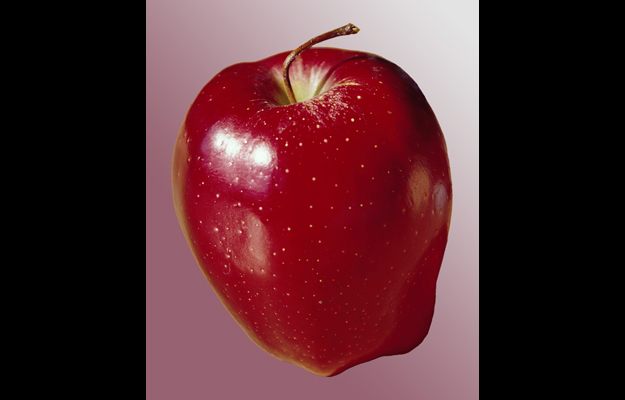
|
||
|
Apple
A simple apple. Tastes good. Looks good. Crunchy. Sweet. Healthy to eat. Great in apple pie. And what about apple crisp? Cut up in a salad. Dried in trail mix. A great addition to a breakfast treat called a Dutch Puff (with a little powdered sugar). Pork chops taste special baked with apple. Apple sauce. There are more than 7,500 known cultivars of apples. Apple cider. Yellow, red, green. About 70 million tons of apples are grown annually worldwide. Apple blossoms are lovely. An apple has about 57,000 genes, the highest number of any plant genome studied to date and more genes than the human genome (about 30,000). It's possible the earliest tree cultivated was the apple. The first apple orchard in the U.S. was planted in Boston. Crab apples are native to the U.S. The apple was considered, in ancient Greece, to be sacred to Aphrodite. Apples must cross pollinate and growers usually use honey bees to do this. Baked apples. Apple butter. Caramel apples. "An apple a day keeps the doctor away" was originally "Eat an apple on going to bed, and you'll keep the doctor from earning his bread." Apple fruit contains good quantities of vitamin-C and beta-carotene. Simple? original photo by dmdart |

|
|||

|
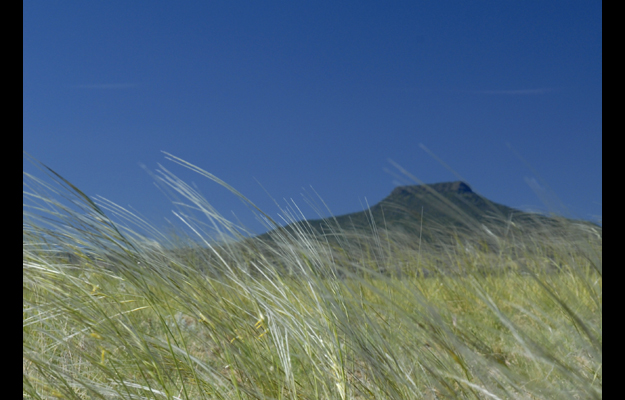
|
||
|
Cerro Pedernal
In the heart of the Jemez Mountains lies Cerro Pedernal. Pedernal means flint in Spanish, and this peak was aptly named. The volcanic process that created this butte left plenty of stone around the peak that is perfect for fashioning crude tools. The native peoples of the area used the rock around this mountain for arrowheads and other tools. Cerro Pedernal is essentially a high, long butte created by a volcanic process. Viewed along its East-West line, it appears as a tall point rising out of the New Mexico desert, but viewed along its North-South vantage, its true shape is more apparent as a long ridge. This mountain creates an inspiring vista among the high desert terrain around the Abiquiu region of New Mexico. Deep reds, greens, and browns mark this area. Its highest point is 9,862 feet. The famous artist Georgia O'Keeffe lived for a time in this area and painted Cerro Pedernal many times. She referred to Pedernal as her "favorite mountain." ~excerpts from various locations and http://www.summitpost.org/cerro-pedernal/154399 Perdernal is visible from miles away and seems to beckon the viewer onward. In the summer, the valley below is filled with sunflowers. At sunset, the colors turn red and purple. At all times, it is an extraordinary sight. original photo by dmdart |

|
|||

|

|
||
|
Bansky
Banksy is a pseudonymous English graffiti artist, political activist, film director, and painter. His satirical street art and subversive epigrams combine dark humour with graffiti executed in a distinctive stencilling technique. His works of political and social commentary have been featured on streets, walls, and bridges of cities throughout the world. Banksy displays his art on publicly visible surfaces such as walls and self-built physical prop pieces. Banksy does not sell photographs or reproductions of his street graffiti, but art auctioneers have been known to attempt to sell his street art on location and leave the problem of its removal in the hands of the winning bidder. Banksy's first film, Exit Through the Gift Shop, billed as "the world's first street art disaster movie", made its debut at the 2010 Sundance Film Festival. The above image is: The Key to Making Great Art is all in the Composition, 2005, Bansky ~excerpts above are from: http://en.wikipedia.org/wiki/Banksy and you can see much more of Bansky's work at: http://banksy.co.uk/ Take some time to go to his site and see the film. It's inventive, original work. |

|
|||

|
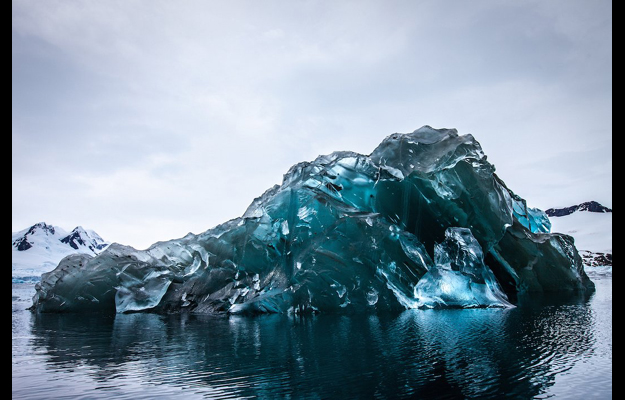
|
||
|
An Iceberg Flipped Over and Its Underside Is Breathtaking
Snow-covered icebergs dominate the scene near the shore of the Antarctic Peninsula, the northernmost part of the icy south polar region. Between the sun, the water and icy peaks, the beauty can be quite literally blinding. This mass rose about 30 feet out the water. Whereas most iceberg tips are covered in snow or have been weathered by the elements, this one is free of debris, exposing glassy, aqua-green ice with water flowing through it. Icebergs form when chunks of freshwater ice calve - or break off - from glaciers and ice shelves, as well as other icebergs. Because of the varying densities of ice and saltwater, only about 10 percent of an iceberg will ever show at the surface, and that protruding tip will gather dirt and snow. Melting can trigger calving, but it can also change the equilibrium of an iceberg, causing it to flip. In the case of this jewel-like iceberg, the ice is probably very old. In glaciers, years of compression force out air pockets and gradually make the ice denser, according to the National Snow and Ice Data Center. "When glacier ice becomes extremely dense, the ice absorbs a small amount of red light, leaving a bluish tint in the reflected light, which is what we see." In addition, minerals and organic matter may have seeped into the underwater part of the iceberg over time, creating its vivid green-blue color. Flipping icebergs are occurring more frequently now due to climate change. Outlet glaciers are rivers of ice that flow outward from an ice cap or ice sheet and into the sea. Outlet glaciers have been retreating in Antarctica and Greenland and this contributes to iceberg flipping. ~excerpt and photo from: http://www.smithsonianmag.com/science-nature/photographer-captures-stunning-underside-flipped-iceberg-180953951/?utm_source=twitter.com&no-ist |

|
|||

|

|
||
|
Lamborghini Countach
The Lamborghini Countach is a mid-engined supercar that was produced by Italian automaker Lamborghini from 1974 to 1990. Its design both pioneered and popularized the wedge-shaped, sharply angled look popular in many high-performance sports cars. The "cabin-forward" design concept, which pushes the passenger compartment forward in order to accommodate a larger engine, was also popularized by the Countach. The word countach is an exclamation of astonishment in the local Piedmontese language. The Countach was styled by Marcello Gandini of the Bertone design studio. Gandini was then a young, inexperienced designer - not very experienced in the practical, ergonomic aspects of automobile design, but at the same time unhindered by them. Gandini produced a striking design. The Countach shape was wide and low (42.1 inches), but not very long (only 163 inches). Its angular and wedge-shaped body was made almost entirely of flat, trapezoidal panels. The doors, a Lamborghini trademark first started with the Countach, were scissor doors: hinged at the front with horizontal hinges, so that they lifted up and tilted forwards. The main reason is the car's tubular spaceframe chassis results in very high and wide door sills. It was also partly for style, and partly because the width of the car made conventional doors impossible to use in an even slightly confined space. The superior performance characteristics of later Lamborghini models appealed to performance car drivers and engineers, but they never had the originality or outrageousness that gave the Countach its distinction. ~excerpt from: http://en.wikipedia.org/wiki/Lamborghini_Countach original photos by dmdart |

|
|||

|
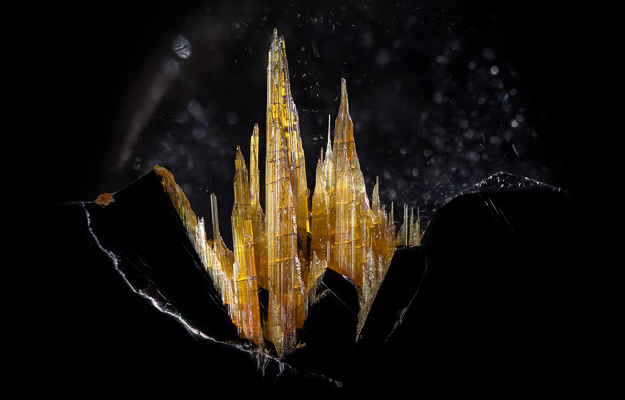
|
||
|
Gems
If you thought gems were beautiful to the naked eye, take a look at them under a microscope. To collectors and sellers, an ideal gem is devoid of excess minerals called inclusions, which are seen as detractors of value or beauty. To many gemologists, inclusions are tools that can help them determine where a gem is from or under what conditions it formed. ~excerpt and photo from: http://www.smithsonianmag.com/science-nature/gems-minerals-inclusions-inside-photography-art-science-180953662/ |

|
|||

|
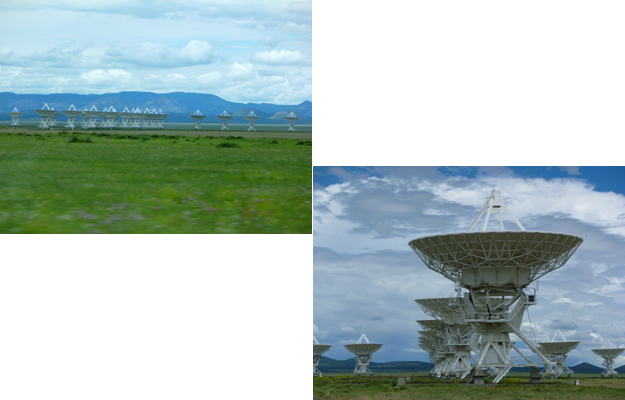
|
||
|
Very Large Array
The Karl G. Jansky Very Large Array (VLA) is a radio astronomy observatory located on the Plains of San Agustin in New Mexico. Astronomers using the VLA have made key observations of black holes and protoplanetary disks around young stars, discovered magnetic filaments and traced complex gas motions at the Milky Way's center, probed the Universe's cosmological parameters, and provided new knowledge about the physical mechanisms that produce radio emission. The observatory consists of 27 independent antennae, each of which has a dish diameter of 82 feet and weighs 209 metric tons. This is a very amazing place and if you are ever in the area you really need to spend time exploring the inside exhibit and walking the grounds. It is so impressive. There are 2 photos here so you can get an idea of the scope from afar and the size from close-up. ~ partial excerpt: http://www.vla.nrao.edu/ original photos by dmdart |

|
|||

|
|||
|
Sanibel Shell in Jemez Springs
Not long ago I visited Jemez Springs, NM. What a spectacular place! Staying in a relatively remote location, in a solar powered house with views that stretched many miles was a unique experience. At night the skies were covered with stars and the black part of the sky was....black. Altitude is about 7000 feet. Mostly low juniper and sage covered the ground. The hummingbirds zipped around humming throughout the days. What I most remember and what was so special was the silence. No A/C units needed. Very little wind sound due to the low brush. Silence. It was almost like a pressure on the senses. Silence. And on an adobe wall surrounding the dwelling was a fighting conch, just sitting there. Like a welcome from home. Sanibel Island, FL visiting Jemez Springs, NM. original photo by dmdart |

|
|||

|
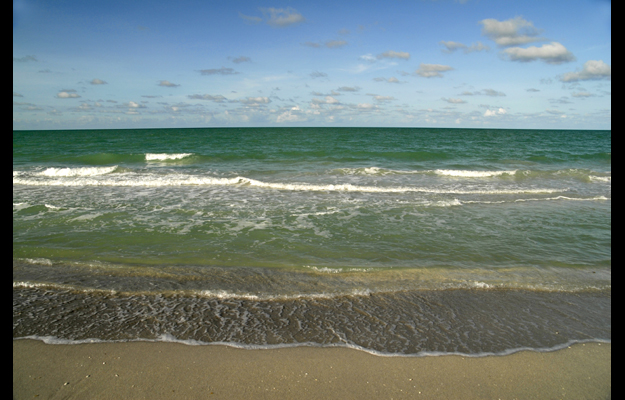
|
||
|
Beach Morning
Probably the majority of people who walk the Sanibel Island beaches are looking for shells. That's why the beaches are famous. But when you walk the beach in the morning you are treated to that special water color that exists when the sun is low on the horizon. The birds are particularly active and some areas can bring a quiet peace that makes you know why you live here. original photo by dmdart |

|
|||

|

|
||
|
Cumbres & Toltec
Built in 1880, the Cumbres & Toltec railroad was part of the San Juan Extension of the Denver & Rio Grande Railroad, with tracks running from Denver through the ore-rich Rocky Mountains to Silverton, Colorado and Santa Fe, New Mexico. Its path through steep passes and deep gorges was an engineering feat for the time. The decline of silver mining in the 1890s ended the railroad's vital role. The Denver & Rio Grande Railroad filed for abandoment in 1969, but the most scenic part of its route, its equipment, and its buildings were saved by the states of Colorado and New Mexico. The Cumbres & Toltec Scenic Railroad is a 3 ft narrow gauge heritage railroad running between Chama, New Mexico and Antonito, Colorado. It runs over 10,015 ft Cumbres Pass and through Toltec Gorge, from which it takes its name. Today, the railroad is the highest narrow gauge steam railroad in the United States. original photo by dmdart |

|
|||

|
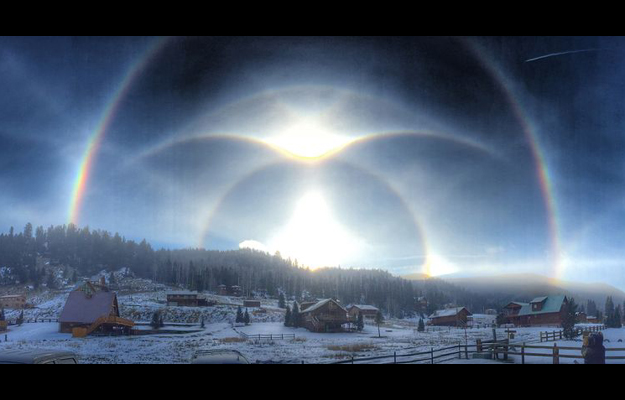
|
||
|
New Mexico Ice Halos
Ice crystals high in Earth's atmosphere can shape light in unexpected and beautiful ways. It's not quite like finding diamonds in the sky, but a photographer in Red River, New Mexico, was lucky enough to catch rainbow-like arcs and pillars of light blazing over a snowy landscape. This example of sunlight run amok is caused by the collision of light and ice crystals high in Earth's atmosphere. Those frozen specks of water bend or refract light in myriad ways to produce arcs, halos, and pillars of light. Air temperatures, as well as the shape and arrangement of ice crystals, fine-tune the phenomena that we see. One of the most prominent features in the New Mexico picture - just above the tree line in the center of the image - is a bright, vertical mass called a sun pillar. Cooler air temperatures boost the brightness of phenomena like these. The circle of light ringing the pillar is a 22-degree halo. These halos are fairly common and are so named because they occur at a 22-degree angle from the sun. They're created by six-sided, or hexagonal, ice crystals. The glaring blob of light to the right of the pillar is called a sun dog, which is the result of ice crystals that are only partly aligned with each other. The delicate strands of light winging out from the top of the sun pillar are tangent arcs. They're formed when tube-shaped hexagonal ice crystals are oriented on their sides. ~excerpt and photo from: http://news.nationalgeographic.com/news/2015/01/150114-ice-halo-weird-weather-phenomena-science/ |

|
|||

|
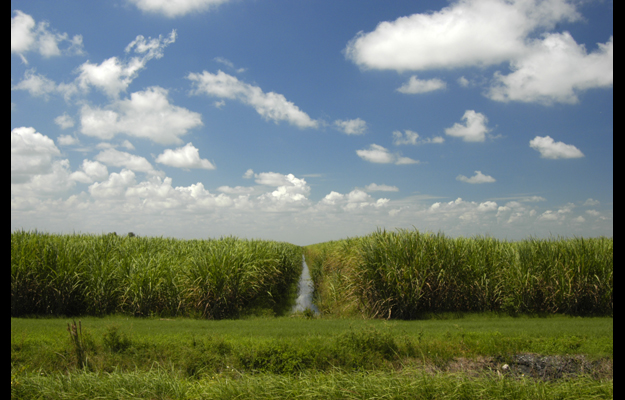
|
||
|
Florida Sugar Cane
A sugar cane field in central Florida near the south end of Lake Okeechobee original photo by dmdart |

|
|||

|
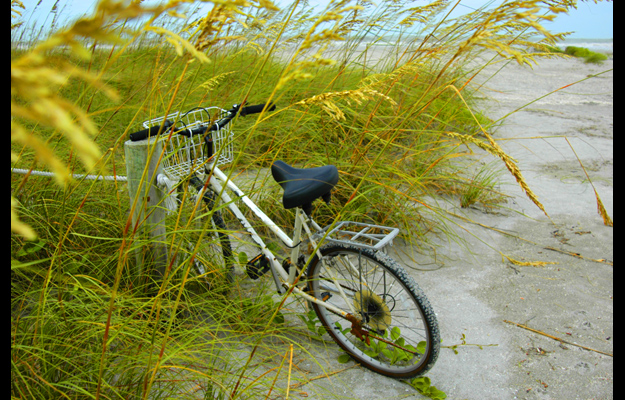
|
||
|
Local Travel
On Sanibel Island, bicycling is a wonderful way to get a feel of the place. You can ride pathways not open to cars, view the lovely native foliage and generally slowly take in the essence of island life. The island has grown greatly since the beginning of my relationship with Sanibel in the 1950's when there were many unpaved, sandy roads, few restaurants, only a couple stores and basically only the noise of nature. Fishing and shelling were our reasons for visiting and we spent the days outside making the most of what the Gulf, the mangroves and the waterways provided. Even with the changes, this place is most special. Hopping on a bike and taking the time to see what's out there is a great way to go. original photo by dmdart |

|
|||

|
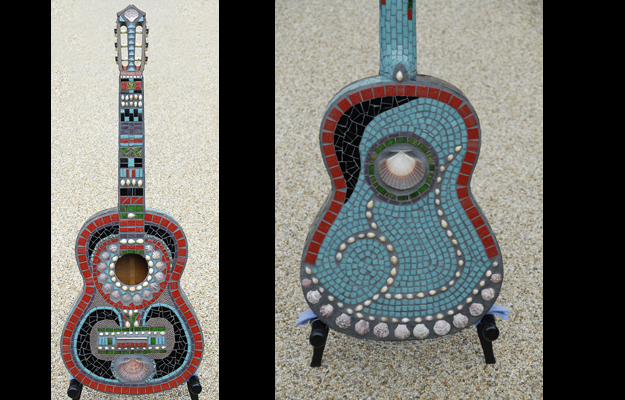
|
||
|
Mosaic Guitar
This standard size guitar is completely covered with glass and shells. Having an interesting base helps the creative process. As with most of my projects, I use elements from my own environmental surroundings and shells worked perfectly to enhance the guitar shape and work within the confines of the unit. Walking the beach looking for these beauties is a great part of the fun. You can see more of my work at: http://www.pinterest.com/0s32wjy77lmcxna/ and www.dmdart.com original photo and mosaic artwork by dmdart |

|
|||

|
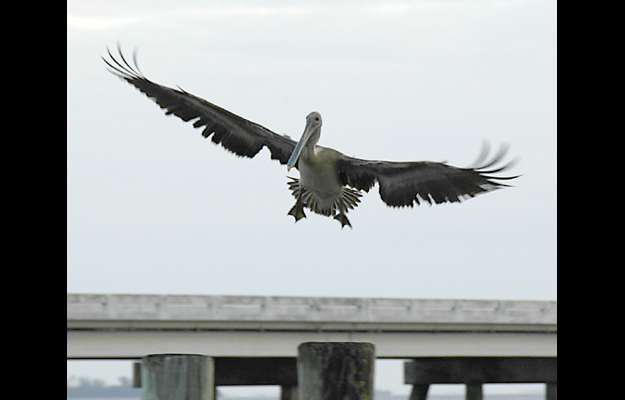
|
||
|
Brown Pelican
Even on gray days the pelicans are out there soaring gracefully overhead, hovering near fishing boats, perched on dock posts, diving head-first and twisting into the water to catch fish, gulping down their catch, and generally living their lives. In groups or alone, they are a sight to see. original photo by dmdart |

|
|||

|
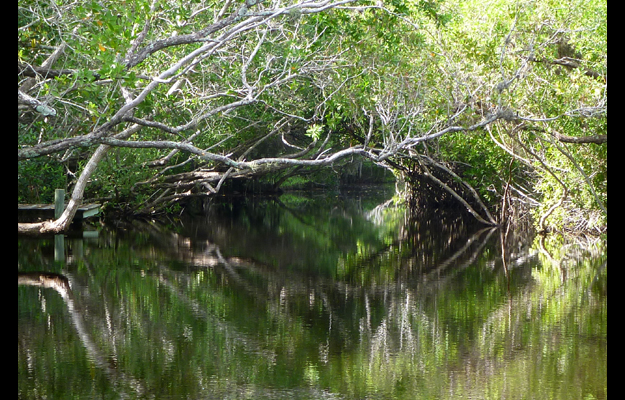
|
||
|
Enter A Secret World
Sanibel, Captiva and surrounding islands abound in "nature", from the multitude of birds (too many to list), raccoons (even during the daylight), armadillos that leave little nose prints in the sand, brown anoles that skitter across bike paths, dolphin and manatees in the surrounding waters and sometimes even in canals right in front of our houses, fiddler crabs in the marshy areas, snakes (poisonous and not), otters gliding through the water, and ..... many other breathing creatures, along with flora of all colors and shapes. A great place to experience the nature of these islands is along the watery pathways through the mangroves. Slipping under the branches, through the quiet, you enter a very special place. If you listen carefully you might hear pistol shrimp make their little cracking noise and if you watch closely you might see a cormorant dive under water to catch its dinner. With eyes and ears tuned to the moment, you will be treated to a secret world. original photo by dmdart |

|
|||

|
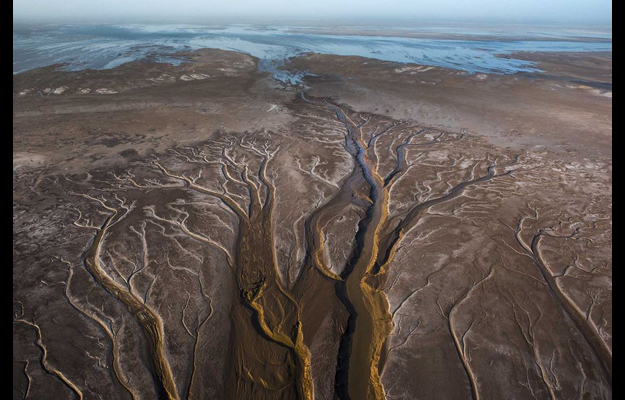
|
||
|
Saving the Colorado River Delta, One Habitat at a Time
A trickle of water is being returned to a few parts of the dried-out delta and those parts are blooming. Thanks to a bi-national agreement, a "pulse flow" of water eventually made its way to the sea, the first time the Colorado River reached the Gulf of California in years. This is part of an innovative effort to restore small parts of the two-million-acre Colorado River Delta. Thanks to dams and canals that have diverted water to farm fields and cities, the Colorado no longer reaches the sea, and its delta has been desiccated. But now a coalition of environmentalists, community leaders, and governments, working under a U.S.-Mexico agreement that is allowing them to reclaim a small fraction of the river's water for the environment, are trying to reverse some of the damage in a few places. Since the pulse release, migratory birds like warblers, sparrows, and woodpeckers have begun showing up again. Those animals have been followed by raptors, rattlesnakes, and coyotes. What's more, the return of water is refilling the groundwater aquifer below. Two-thirds of the water has already been provided, in equal parts by the U.S. and Mexican federal governments, as a single pulse of 105,392 acre-feet. It was released last March from Lake Mead through Hoover Dam. Over a period of about eight weeks, it flowed down the Colorado and into the river's original channel at Morelos Dam in Mexico. The results have been dramatic. Thousands of trees sprang up along the banks. Groundwater was recharged. For the first time in many years, the Colorado River reached the sea - and a lot of people along the way. The goal is to restore blocks of each type of original habitat, from the riparian forest at Miguel Aleman to brackish marshes in the middle of the delta to mud flats where the river once emptied into the Sea of Cortez (Gulf of California). ~excerpts: http://news.nationalgeographic.com/news/special-features/2014/12/141216-colorado-river-delta-restoration-water-drought-environment/ Photograph by Peter McBride, National Geographic Creative |

|
|||

|
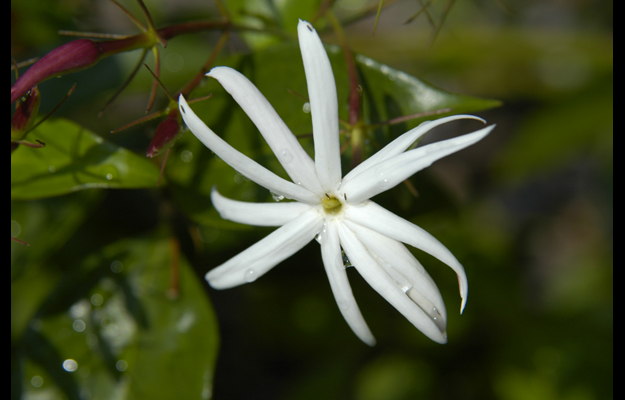
|
||
|
Jasmine
Jasmine comes in many varieties. This is commonly called Star Jasmine. The plant is very viney, sending out long shoots, and when it's in bloom, the white stars cover the plant and give off a wonderful sweet scent. You can find the plant throughout Sanibel and Captiva islands. original photo by dmdart |

|
|||

|
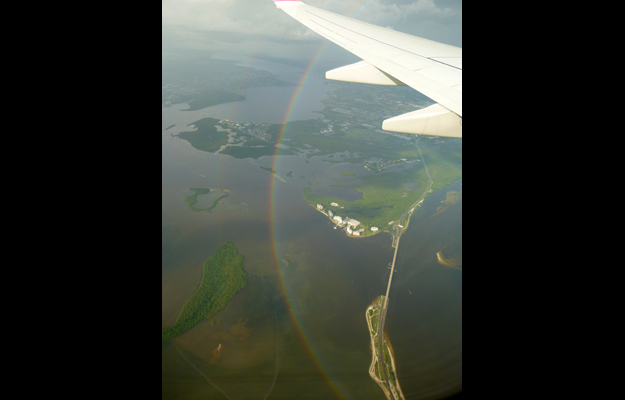
|
||
|
Rainbow Over Sanibel Island
Many people fly into or out of Regional Southwest airport (Fort Myers, FL) this time of year. Some flights travel over Pine Island, Matlacha and Sanibel/Captiva and it's fun to pick out places you know. You get an entirely different perspective from the air. I returned from a trip into a rain storm. We circled a bit and on one of the passes before landing a rainbow made an arc over the causeway entrance to Sanibel. From this vantage point you are looking from Sanibel toward Fort Myers, you can see the first causeway island, a bit of Cape Coral and up the Caloosahatchee, with a great view into the waters of Pine Island Sound. The sights flying into southwest Florida are usually quite astounding: the waters are clear and the colors just explode. Even this rainy evening brought a gift of beauty. original photo by dmdart |

|
|||

|
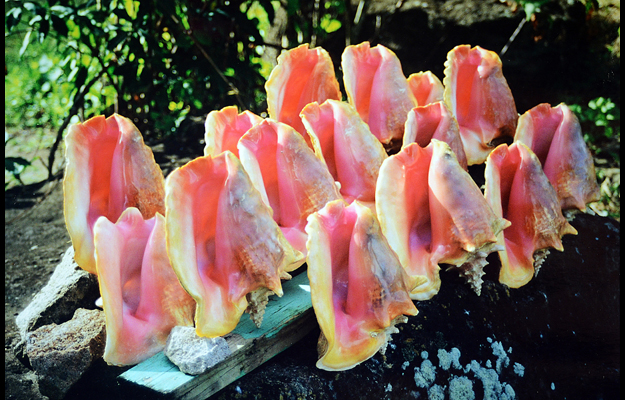
|
||
|
Queen Conch (also Pink Conch)
Nevis, in the Leeward Island of the West Indies, is a lovely, slow-moving, tropical haven. In my youth I was lucky enough to spend time there, being minimally involved with a family venture. Years later, the island has remained mostly unchanged. It's fun to drive the roads, some paved, some not, all with spectacular views up to the mountain or down to the sea, a rain forest, tropical fauna and flora and colorful structures around every corner. This display of conchs was just on the side of the road and eye-catching for each person passing. original photo by dmdart |

|
|||

|

|
||
|
Stephen Hawking (Jan 8, 1942)
Stephen Hawking has worked on the basic laws which govern the universe. With Roger Penrose he showed that Einstein's General Theory of Relativity implied space and time would have a beginning in the Big Bang and an end in black holes. These results indicated that it was necessary to unify General Relativity with Quantum Theory, the other great scientific development of the first half of the 20th Century. One consequence of such a unification that he discovered was that black holes should not be completely black, but rather should emit radiation and eventually evaporate and disappear. Another conjecture is that the universe has no edge or boundary in imaginary time. This would imply that the way the universe began was completely determined by the laws of science. Among the popular books Stephen Hawking has published are his best seller A Brief History of Time, Black Holes and Baby Universes and Other Essays, The Universe in a Nutshell, The Grand Design and My Brief History. Professor Hawking has twelve honorary degrees. He was awarded the CBE in 1982, and was made a Companion of Honour in 1989. He is the recipient of many awards, medals and prizes, is a Fellow of The Royal Society and a Member of the US National Academy of Sciences. Professor Hawking was diagnosed with ALS, a form of Motor Neurone Disease, shortly after his 21st birthday. In spite of being wheelchair bound and dependent on a computerised voice system for communication Stephen Hawking continues to combine family life (he has three children and three grandchildren), and his research into theoretical physics together with an extensive program of travel and public lectures. He still hopes to make it into space one day. ~excerpt from www.hawking.org.uk There so much more to read about Professor Hawking on the Internet and in his books. You can start with the above link, but don't stop there. The artist's concept above shows a supermassive black hole with millions to billions times the mass of our sun. Supermassive black holes are enormously dense objects buried at the hearts of galaxies, and fundamental aspects of their behavior have baffled scientists. Image by NASA/JPL-Caltech: http://www.nasa.gov/centers/jpl/news/nustar20130227_prt.htm |

|
|||

|
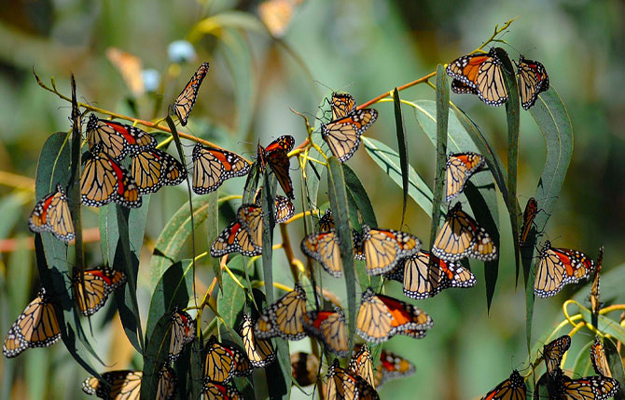
|
||
|
Monarch Butterfly May Join Endangered Species List
I mourn for each creature that is harmed by mankind's actions, whether well-meaning or senseless. I will admit that some losses affect me more strongly. (I'm human.) The killing of Rhinos to utilize their horns for virility enhancement disgusts me, though some people who follow this practice base their beliefs on ancient medicinal arts. The fact that there are less than 100 Florida Panthers left in the wild is heartwrenching. I once created an art piece that incorporated the Carolina Parakeet that had inhabited a good portion of the U.S., a most beautiful bird of yellow and bright green: the species was declared extinct in 1939. I have watched Monarch Butterflies during the summers of my life. They are ethereal. Their patterns are phenomenally bright, crisp and artistic. And now the news is that these creatures of our life may be added to the Endangered Species list. What a tragedy. --- The Monarch Butterfly's numbers have declined dramatically in North America. Over the past 20 years, North America's population of monarch butterflies has declined by a catastrophic 90 percent, a plight that may be caused by pesticides and loss of the once-vast acres of wild milkweed that are the creatures' food source. On Dec. 29, the U.S. Fish and Wildlife Service announced that it is launching a scientific review to determine whether the monarch butterfly should be protected by law under the Endangered Species Act, a 1973 law designed to protect species from becoming extinct. The Xerces Society said the North American population of monarchs has declined from 1 billion in 1996 to just 35 million this past winter, the lowest number ever recorded. Xerces tied the decline of monarchs to the widespread planting of genetically modified corn and soybean crops in the U.S. Midwest, where most of the butterflies are born. The GMO plants are designed to be immune to an herbicide that kills off milkweed. Over the last two decades, monarchs have lost more than 165 million acres of habitat - an area roughly the size of Texas. In addition, butterflies are threatened by climate change, drought, urban sprawl and logging on their Mexican winter range. Monarchs need a very large population size to be resilient to threats from severe weather events and predation. Nearly half of the overwintering population in Mexico can be eaten by bird and mammal predators in any single winter; a single winter storm in 2002 killed an estimated 500 million monarchs - 14 times the size of the entire current population. ~excerpt and photo from: http://news.discovery.com/animals/monarch-butterfly-may-join-endangered-species-list-141231.htm. Additional excerpt from www.xerces.org/ Help Save the Monarch: https://www.fws.gov/savethemonarch/ Send this link to anyone you think would be interested in reading this entry. |

|
|||

|

|
||
|
Turquoise
Turquoise is the most wonderful stone: the polished color ranges through blues and greens with designs of matrix (the brown/tan) running throughout. I "found" this piece in Window Rock, AZ and I saw a pendant living in it. The simple beading around the edge is merely a finishing element: 5 rows deep of tiny glass beads catches the color of the matrix and frames the lovely blues of the stone. The history of turquoise is interesting in itself and adds to the stones allure. Turquoise is perhaps the oldest stone in man's history, the talisman of kings, shamans, and warriors. It is a stone of protection, strong and opaque, yet soothing to the touch, healing to the eye, as if carved from an azure heaven and slipped to earth. Its unique shade of blue, often blue-green, lends it name, Turquoise, to all things of this tranquil hue. The delicate veining or mottled webbing in cream or brown is inherent to the stone and serves to enhance its character. The name Turquoise is derived from the French, pierre turquoise, meaning "Turkish stone," because the trade routes that brought Turquoise to Europe from the mines in central Asia went through Turkey, and Venetian merchants often purchased the stone in Turkish bazaars. For thousands of years, Turquoise has spanned all cultures, prized as a symbol of wisdom, nobility and the power of immortality. Among the Ancient Egyptians, Persians and Chinese, Aztecs and Incas of South America, and Native North Americans, Turquoise was sacred in its adornment and for power, luck, and protection. Turquoise beads dating back to 5000 B.C. have been found in Iraq, and the Egyptians were mining the stones in the Sinai in 3200 B.C. The death mask of Tutankhamun was studded with Turquoise, as were the mosaic masks dedicated to the gods, the fabulous inlaid skulls, shields and power statues of Moctezuma, the last ruler of the Aztecs. For nearly a thousand years, Native Americans have mined and fashioned Turquoise, using it to guard their burial sites. Their gems have been found from Argentina to New Mexico. Indian priests wore it in ceremonies when calling upon the great spirit of the sky. Many honored Turquoise as the universal stone, believing their minds would become one with the universe when wearing it. Because of its ability to change colors, it was used in prophesy or divining. To the prehistoric Indian, Turquoise, worn on the body or used in ceremonies always signified the god of the sky alive in the earth. This excerpt is from www.crystalvaults.com/crystal-encyclopedia/turquoise but there is much to read about turquoise (including "Tiffany turquoise") and many different ideas about it's meanings. original photo and beadwork by dmdart |

|
|||

|
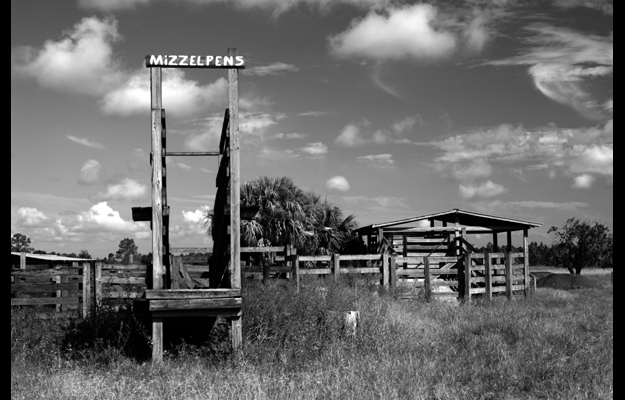
|
||
|
Rural Routes
Having lived a good portion of my life in Florida, I remember less-crowded roads, secluded places to stop on drives to the Keys, across Tamiami Trail or up the coast. Most roads are now fairly packed with cars and people on their way to vacation destinations. Summertime has a much quieter feel. I take to get out and drive the back roads, sometimes being the only car in view. The photographs I take during those drives show the rural landscapes that still exist, but are not seen in the tourist ads and are by-passed by most drivers. Here is one back road view. original photo by dmdart |

|
|||

|

|
||
|
Fish + Shells + Beads = Pendant
The best part, to me, of the beading process is searching through what nature gives us to find the perfect element(s) to incorporate and then working them together into a harmonious piece. Since my natural surrounding is Sanibel Island, FL, I am drawn to shells and the colors of the Gulf of Mexico. So here are an olive shell, 2 augers, a piece of cockle shell, a nugget of turquoise for good luck and a matte lapis fish head from Tibet. original photo and beaded pendant by dmdart See it at www.etsy.com/listing/210545166/bead-embroidery-beadwork-jewelry? |

|
|||

|
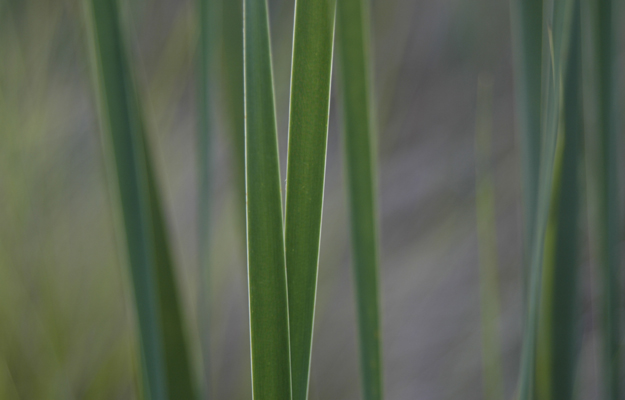
|
||
|
New Year's Contemplation
Storage It is a simple thought to say the soul, in a way, must be quite like an old cellar. A space to hold things or hold space for light or shadow to shine forth. A place of whole acceptance, cradling all until filled or over filled -- boxes stacked and shelves stuffed, webs and mold and micro worlds proliferating the unattended darkness. To most folks, the things feel put away, dealt with, yet a burden appears plainly in the heavy eyes and heavier steps of the attending body. The cellar can, of course, be cleaned and cleared, swept out and lit up, the stacks slimmed, the files trimmed, the shelves relieved and lightened. The door can be opened to new air, a window dug and built to permit sunshine and moon glow, a song hummed into the bare walls and cold floors. All that is surely good, it seems -- a refreshment, a warming, an illumination. It is also good, essential really, to descend into the storage space on a moonless night and feel the crawling and prowling of animal and spirit, to stand silently before the long shut-up boxes on leaning shelves and simply weep until morning or sleep sweeps you up and carries you back into the comforts of the living room. ~by Timothy P McLaughlin, a poet and spiritual teacher. He taught in Native communities of South Dakota, Montana, and New Mexico for 13 years and founded the Spoken Word Program at the Santa Fe Indian School. He and his students received numerous awards and were featured in many publications and programs, among them the New York Times and the PBS News Hour. ~excerpt from THE, Santa Fe, NM's monthly magazine to and for the Arts: August 2014 original photo by dmdart |
|
|
|
home |
photography |
3d art |
technology |
diverse |
archive |
comments |
dmdart.com |
zebis.com |
sitemap |
contact me by e-mail
|
| © 2014-2015 dmdart.com/blog : a very small division of Zebis, Inc. - All rights reserved. |